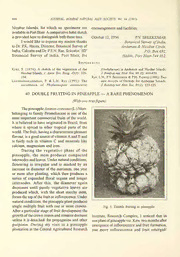
Double fruiting in pineapple: A rare phenomenon PDF
Preview Double fruiting in pineapple: A rare phenomenon
600 JOURNAL, BOMBAY NATURAL HIST SOCIETY, Vol. 94 (1997) Nicobar Islands, for which no specimens are encouragement and facilities. A available in PortBlair. comparative habitsketch is provided here to distinguish both these taxa. October 12, 1996 P.V. SREEKUMAR I would like to express my sincere thanks Botanical Survey ofIndia, to Dr. P.K. Hazra, Director, Botanical Survey of Andaman & Nicobar Circle, India, Calcutta and Dr. P.S.N. Rao, Scientist ' SD' P.O. Box 692, Botanical Survey of India, Port Blair, for Haddo, Port Blair-744 012. References Kurz, S. (1876): A sketch of the vegetation of the (Orchidaceae) in Andaman and Nicobar Islands. Nicobar Islands, J. Asiat. Soc. Beng. 45(3): 1OS- J. Bombay nat. Hist. Soc. 88 (3): 469-470. 164. Ray, L.N., P.V. Sreekumar & P.M. Padhye (1996): Two Lakshminarasimhan, P. & L.N. Ray (1991): The new records of Orchids for Andaman Islands. occurrence of Phalaenopsis cornucervi J. Bombaynat. Hist. Soc. 93(1): 123-125. — 40. DOUBLE FRUITING IN PINEAPPLE A RARE PHENOMENON (With one text-figure) ThepineappleAnanas comosus (L.) Merr. belonging to family Bromeliaceae is one ofthe most important commercial fruits ofthe world. It is believed to have originated in Brazil, from where it spread to other tropical parts of the world. The fruit, having a characteristic pleasant flavour, is a good source ofvitamin A and B and is fairly rich in vitamin C and minerals like calcium, magnesium and iron. During the vegetative phase of the pineapple, the stem produces compacted internodes and leaves. Undernatural conditions, flowering is irregular and is marked by an increase in diameter of the meristem, one year or more after planting, which then produces a series of expanded floral organs and longer internodes. After this, the diameter again decreases until purely vegetative leaves are produced which, with the short starchy stem, forms the top ofthe fruit or inflorescence. Under natural conditions, the pineapple plantproduces single multiple fruit with one or more crowns. Fig. 1. Double fruiting in pineapple. After a particular stage offruit development the growthofthe crown ceases and remains dormant Institute, Research Complex, I noticed that in unless it is detached for propagation and other oneplantofpineapplevar. Kew, two months after purposes. During my visit to a pineapple emergence ofinflorescence and fruit formation, plantation at the Central Agricultural Research one more inflorescence and fruit emerged/ MISCELLANEOUS NOTES 601 developed from the crown of the same fruit study on nutritional, cytogenetic and physio- having multiple crowns. Both the fruits on a logical aspects. single peduncle developed and ripened simultaneously, thus giving the appearance of a October 12, 1996 D.B. SINGH single fruit in late stage. Whateverthe causemay Central Agricultural Research Institute be, this phenomenon is rare and needs further Port Blair-744 101. — POA NEPHELOPHILA BOR A NEW RECORD TO INDIA 41. FROM GARHWAL HIMALAYA (With one text-figure) During plant explorations in Garhwal 1-nerved, margins hyaline, keel scabrid above; Himalaya, someinteresting specimens ofPoawere upper glumes elliptic, acute or acuminate, mm collected from Yamnotri in Uttarkashi district. 2.5 long, 3-nerved, margins hyaline, keel Criticalanalysis ofthe specimens ofthe species as ciliate to the basal half or more, remainder mm well as perusal ofliterature confirmed theidentity scabrid; paleas elliptic, oblong, 2.5 long, ofthe species as Poa nephelophila, so far known with long ciliate keels. Stamens 3; anthers 0.6 mm from Myanmar (Burma), hitherto not reported long. Ovary ovoid, glabrous. & from India (Bor 1960, Rajbhandari 1991). FL Fr.: September-October. The present communication pertains to the Rare - on alpine slopes, associated with other detaileddescriptionandillustrations ofthespecies, grasses and herbs. along with short notes on its distribution, and Specimen examined: Yamnotri (Uttarkashi) collector’s Herbarium number. The voucher 3300 m; D.C. Nautiyal; GUH 14917. specimens are depositedinthe Herbarium, H.N.B. Distribution: Previously the plant Garhwal University, Srinagar (GUH). was reported from Burma, Chimlipass, above m PoanephelophilaBorinKew Bull. 1948: 140. 3300 (Bor, 1990). 1948; inJ. Bombay nat. Hist. Soc. 50: 819. 1952; Thisis averyleafy species closelyresembling GBCIP. 558.1960; RajbhandariIn TheHimalayan robust forms ofPoa annua L. However, it mainly & Plants (ed. Ohba Malla) 2: 222. 1991. differs in having 4 lower panicle branches and mm Annual, glabrous grasses; culms erect or ligules 1.1-1.2 long, (Poa annua has 1 or 2 ascendingfrom the geniculatebase, 20-38 x0.15 lowerpaniclebranches and ligules measures 1.5- mm cm, leafy; nodes 2-3, shining. Leaves flat, linear- 3 long). acuminate, 10-12x0.3-0.5 cm, glabrous on the Acknowledgement margins and both surfaces or minutely scabrid, We are thankful to the Council of Scientific withroundedbase, dark-greenincolour; sheaths and Industrial Research, New Delhi, forfinancial 6-16 cm long, glabrous ligules rounded at the mm assistance. apex, 1. 1-1.2 long, outer surface glabrous. RD GAUR Panicles pyramidal, 8-12 x 2-3 cm; branches June 15, 1996 NAUTIYAL spreading, smooth, lower branches 4; spikelets D.C. mm oblong, 5.5 long, 4-6 flowered. Lower Department ofBotany, mm glumes elliptic-oblong, acuminate, 1.8 long, H.N.B. Garhwal University, Srinagar-246 1 74, References Bor, N.L. (1960): The Grasses ofBurma, Ceylon, India poa L. (Gramineae) in The Himalaya. In and Pakistan, London. The Himalayan Plants (ed. H.Ohba & S.B. Malla) Rajbhandari, K.R. (1991): A Revision of the Genus pp 169-263.,
